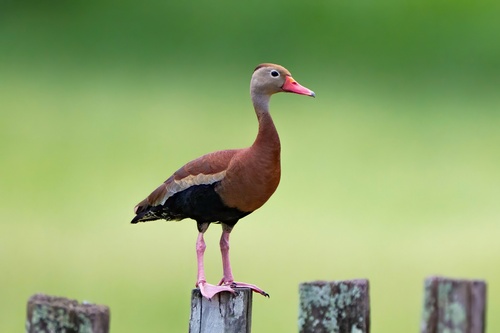
Black-bellied Whistling-duck
The Black-bellied Whistling-Duck (*Dendrocygna autumnalis*) is a striking waterfowl species known for its long legs, upright posture, and distinctive black belly contrasting with a chestnut breast and back. Unlike many duck species, it exhibits a strong pair bond and is often seen in groups. It plays an ecological role as both a seed disperser and a consumer of aquatic invertebrates and vegetation. Black-bellied Whistling-Ducks are also culturally significant in some regions, featuring in folklore and sometimes kept as ornamental birds.
47-56 cm
Length
76-94 cm
Wingspan
Least Concern
Conservation Status
Distribution
The Black-bellied Whistling-Duck has a wide range, extending from the southern United States (primarily Texas, Louisiana, and parts of Arizona and Florida) through Mexico, Central America, and into South America as far south as northern Argentina and Uruguay. Some populations are resident, while others undertake short-distance migrations.
Lifespan
Up to 10 years in the wild; longer in captivity.
Black-bellied Whistling-duck's Habitat
Habitat Types
Freshwater marshes, Shallow lakes, Rice paddies, Mangrove swamps, Flooded grasslands, Reservoirs
Climate Zones
Tropical, Subtropical, Warm Temperate
Adaptations
Their long legs and necks are well-suited for wading in shallow water and foraging among emergent vegetation. They are also capable of perching on branches, a trait not common to all ducks.
Variations
Two subspecies are generally recognized: *D. a. autumnalis* (northern) and *D. a. discolor* (southern), with slight differences in coloration and size.
Appearance
Breeding Plumage
Plumage is relatively consistent year-round.
Seasonal Feather Changes
No significant seasonal variations.
Sex Based Plumage Differences
Males and females have very similar plumage.
Notable Features
Black belly and lower breast, Chestnut upper breast and back, Bright pink bill and legs, White eye-ring, Large white wing patch visible in flight
Diet and Feeding
Primary Foods
Seeds, Grains (rice, corn), Aquatic plants, Insects, Small invertebrates
Foraging Behavior
Black-bellied Whistling-Ducks primarily feed by dabbling in shallow water, grazing on vegetation, and gleaning seeds from the surface. They also upend to reach submerged plants. They are often seen foraging in fields, especially rice paddies.
Specializations
Their long necks allow them to reach food in slightly deeper water than some other dabbling ducks.
Seasonal Diet Variations
Diet may shift depending on food availability. For example, they may consume more grains during harvest seasons.
Behavior
Social Structure
Black-bellied Whistling-Ducks are highly social, often found in flocks, sometimes numbering in the hundreds or even thousands, especially outside of the breeding season.
Communication
Loud, whistling calls (hence the name), Visual displays (head bobs, wing flapping)
Migration
Some populations are resident, while others undertake short-distance migrations in response to water availability or food resources. They are generally not long-distance migrants.
Territorial or Group Behaviors
While generally gregarious, pairs will defend a small territory around their nest site during the breeding season.
Conservation
Threats
Habitat loss (wetland drainage), Hunting (in some regions), Pesticide exposure, Lead poisoning (from ingestion of spent shot)
Protection Programs
Wetland conservation and restoration efforts, Hunting regulations (in some areas)
Local National Laws
Protected under the Migratory Bird Treaty Act in the United States.
Population Trend
Increasing
Population Estimates
The global population is estimated to be between 1,100,000 and 2,000,000 individuals.
Interesting Facts
They are known for their strong pair bonds.
Unlike many duck species, Black-bellied Whistling-Ducks often mate for life.
They are cavity nesters.
They readily use nest boxes, making them a good candidate for citizen science projects.
Ducklings can swim and dive shortly after hatching.
This precocial development helps them avoid predators.
They are sometimes called "tree ducks".
Due to their habit of perching in trees.
Faqs about Black-bellied Whistling-duck
Are Black-bellied Whistling-Ducks noisy?
Yes, they are known for their distinctive, loud whistling calls.
Do they migrate?
Some populations are migratory, but many are resident, especially in tropical areas.
What do they eat?
They have a varied diet, including seeds, grains, aquatic plants, and invertebrates.
Are they related to whistling swans?
No. Though they are both in the family Anatidae, Whistling-Ducks are in the subfamily Dendrocygninae, while swans are in the subfamily Anserinae.
Copyright @ Nature Style Limited. All Rights Reserved.
 English
English